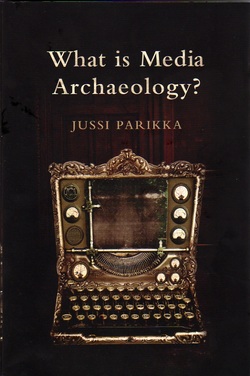
Parikka is a Finnish scholar who currently teaches at the University of Southampton. My impression from this perhaps understandably Eurocentric book is that “media archaeology” is a much larger field than he currently envisions. I didn’t find any specific references to writers’ uses of technology in any of the chapters, although clearly inventions such as paper, the alphabet, moveable type, the fountain pen, the typewriter, the tape recorder, the Selectric typewriter, the word processor, the phototypesetter, the modem, the internet, e-books and search engines have altered how and what writers can write as well their conceptions of collaboration, intellectual property, originality and what it means culturally to be a literary practitioner. In 1984 when Fred Wah and I put the world’s first electronic literary magazine, SwiftCurrent, on-line and invited writers to participate we encountered established writers who were unable to type, poets worried that their ideas might be stolen, fiction writers horrified that we intended to do no editing, a surprisingly large proportion of
Parikka does discuss “artists” but these seem to be mostly installation artists who currently produce work for the high-end of the art market – large galleries, corporations and public institutions – and who work in a dozen or less major European and American cities. He has a fondness for objects which can be displayed or photographed and kinetic sculptures which can be observed in action. He seems much more interested in what he calls “software culture” and “digital culture” than in the long centuries of pre-digital media/technologies. The curatorial work he discusses is similarly situated, and focussed mostly on items of obsolete twentieth-century technology and abandoned and decaying forms of magnetic media. The latter is somewhat relevant to writers who may have a box of floppy disks left over from their Apple IIs, or a stash of reel-to-reel recordings of 1960s poetry readings, but it overlooks the curatorial problems that arise from the chapbooks printed by writers in the 1970s on primitive photocopy machines, the drawings created by visual artists in the fluorescent but impermanent colours of “magic markers,” or texts and images many exchanged through the international use of early fax machines. Some of the writers and artists of that period were critiquing the new media through this use, as were those who photocopied and re-photocopied a text or image to create a series of increasingly degenerating instances. Most of the ongoing curatorial media archaeology that I am aware of is taking place outside of the range of Parikka’s book – the on-line archiving of literary tape recordings by Slought Foundation, ubuweb, and Concordia University’s Spokenweb project, and various librarians’ attempts to conserve the early examples of photocopy and fax machine art and literature.
In general, What is Media Archaeology is more an elaborately annotated bibliography of the work to date in this nascent field than it is a sustained argument by Parikka himself. Perhaps fittingly for a work in a field which he argues attempts to “investigate[] non-human temporalities and ... not succumb to individualizing stories of heroes (167), Parikka seems to avoid presenting his own ideas and to instead present the book’s arguments as the accumulating collaborative findings of his colleagues – colleagues whose own work often reaches back to much earlier technologies than Parikka's appears to, but who also seem to have not been much interested in writers or literature. Literary scholars who are finding the book useful are extrapolating from the methodologies and perspectives it presents rather than working on any specific observations. One such observation is Parikka's Foucault-derived suggestion that media archaeology can uncover the “conditions of existence” of past decades of digital culture and thus help explain its politics and its artistic productions; a second is that the material structure of digital objects – the closed architecture of most contemporary computers, the introduction of ‘cloud computing’ and its physically remote servers – may have unsuspected consequences for how people behave and create. A third is his observation that, given the usual five-year life span of magnetic media, the digital archive presents more urgent curatorial problems than the traditional paper one. The archived materials need to be regularly re-recorded both on their current media and on new media. Digital artworks that built on specific operating systems and computer languages will have to be translated and re-translated into ones currently available for use.
That third observation is one that has troubled me since the 1980s when I began donating the records of digitally produced text to the university library that has been collecting and storing my manuscripts and correspondence. Today, I have still not yet trusted that library to have the resources to conserve a digital record, and so have continued to donate my email correspondence as printouts only and allowed the digital email records to perish. Aware that 1980s wordprocessing software would be unreadable in the following century, I donated my manuscripts also as paper copies only, and have kept the hundreds of floppies, 3.5" diskettes, and thumb drives in ever more dusty boxes. Despite the proliferation of digital technologies, paper has remained the more durable medium – less durable than stone inscriptions but much more so than flash memory. But eventually the library will want to digitize its fonds – and at that point will need to have assured resources for the maintaining of a digital collection. And for some of its collection it may also need a media archaeologist.
FD
 RSS Feed
RSS Feed